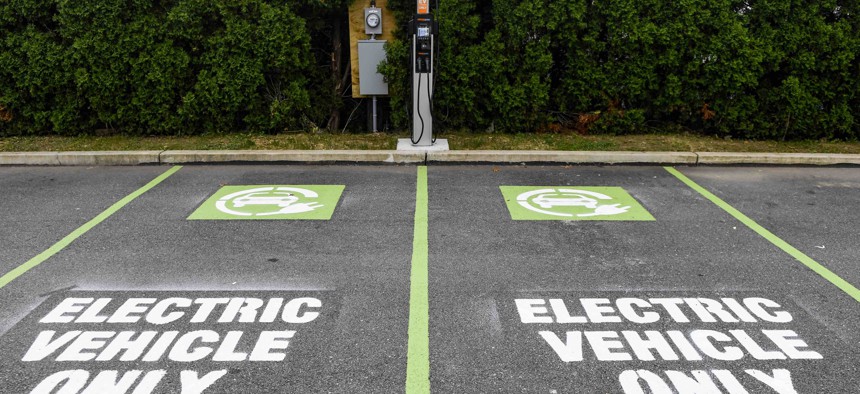Biden Administration Outlines Plans for National EV Charging Network

Ben Hasty/MediaNews Group/Reading Eagle via Getty Images
Federal officials detailed how they expect states to spend $5 billion from the new infrastructure law to place electric vehicle chargers along key interstate highways.
The Biden administration will use the first round of cash it’s giving states to build electric vehicle chargers to focus on making sure drivers on highways are never too far from getting a quick charge-up.
The focus on high-traffic corridors is one of many details included in new guidance released Thursday by the Federal Highway Administration. The 31-page document outlines how states should prepare to spend $5 billion in new federal money for chargers included in the recently passed infrastructure law.
The FHWA will release more details in 90 days, when it issues formal requirements, rather than the overview it released Thursday.
In most cases, the federal government will pick up 80% of the cost of charger projects and require states to pay for the remaining 20%, a similar breakdown to most federally funded road spending.
Federal officials will focus their initial efforts on installing fast-charging stations, which can replenish a car’s battery in about half an hour, rather than the slower chargers more commonly found in homes and office parking lots.
Senior Biden administration officials, speaking on background, also said agencies will require new chargers to use a standard and convenient payment system. That would address concerns that many charging networks use proprietary payment methods, making it difficult for new customers to use their services.
The release of the guidance starts a months-long process for states to get their share of the charging money. Once formal requirements come out in 90 days, states will have to submit a plan showing how they will use the funding. The FHWA will decide whether those state plans meet the federal criteria by Sept. 30.
The state plans “are the building blocks that will facilitate this national [electric vehicle] charging network. This national [electric vehicle] charging network will provide [electric vehicle] users with the confidence that they can travel long distances and expect reliable access to [electric vehicle] charging stations when needed, while also recognizing the unique needs of different regions and communities,” the federal guidance explains.
The FHWA said states should focus their initial plans on building stations along “alternative fuel corridors,” or stretches of interstate highways designated by the federal government for use by vehicles that don’t run on gasoline or diesel. States can also ask the FHWA to designate new stretches of highway to be part of those corridors.
The guidance says that the corridors should have publicly available charging stations within one mile of the highway at least every 50 miles. Each of those stations should have at least four fast chargers installed.
The FHWA will hand out the $5 billion for states over five years.
After the first year, states can use the federal charging money for other types of publicly available chargers, if they completely build out fueling stations along the alternative fuel corridors. Other places they can install chargers include parking lots, transit stations, schools, parks, visitor centers and on federal lands.
The Biden administration’s guidance also instructs states to demonstrate how their plans for rolling out electric vehicle chargers will address equity concerns, improve job opportunities and protect against cyber-attacks.
Daniel C. Vock is a senior reporter for Route Fifty based in Washington, D.C.
NEXT STORY: McConnell Tells Governors They Can Ignore Biden Highway Priorities






